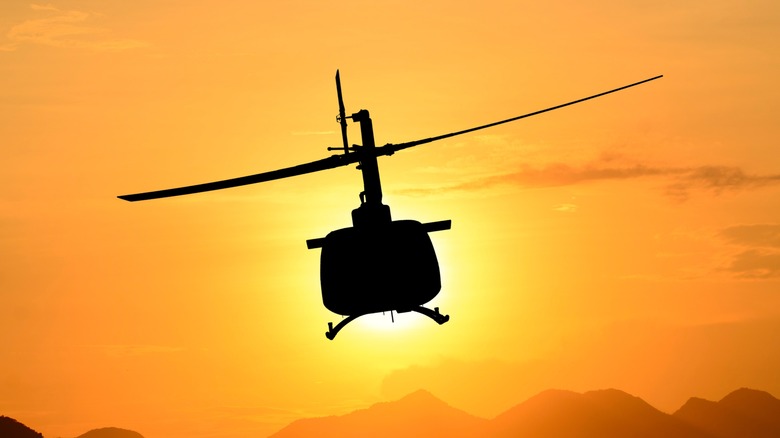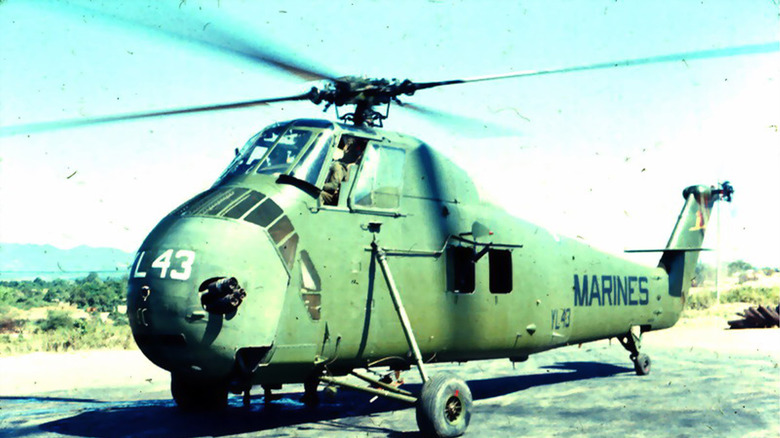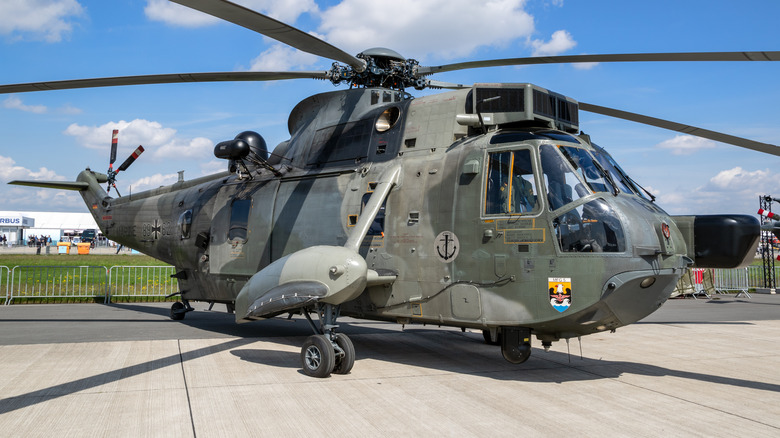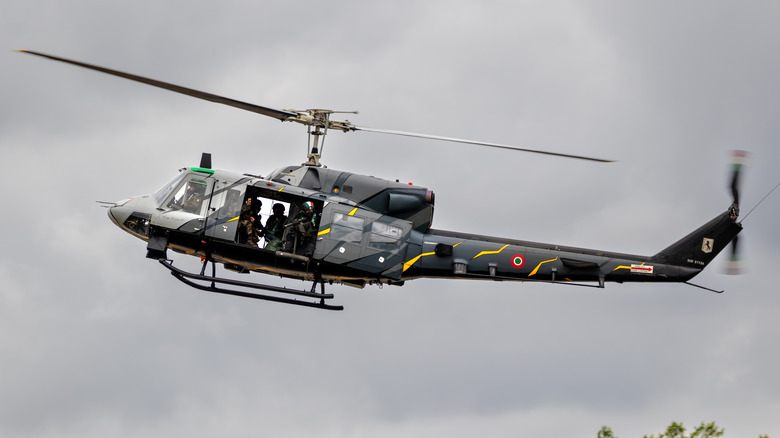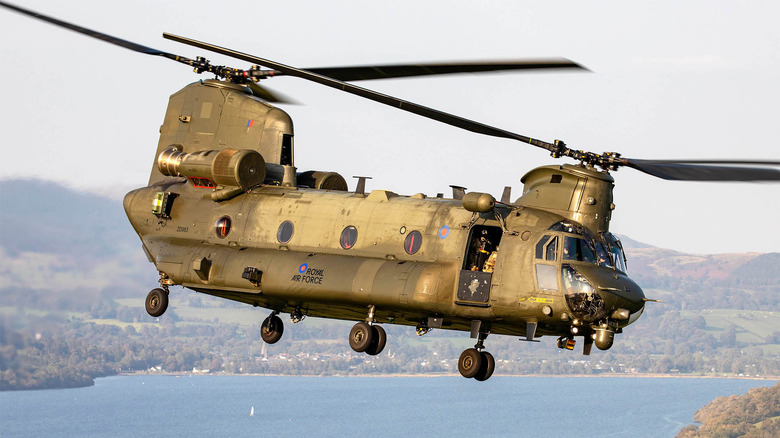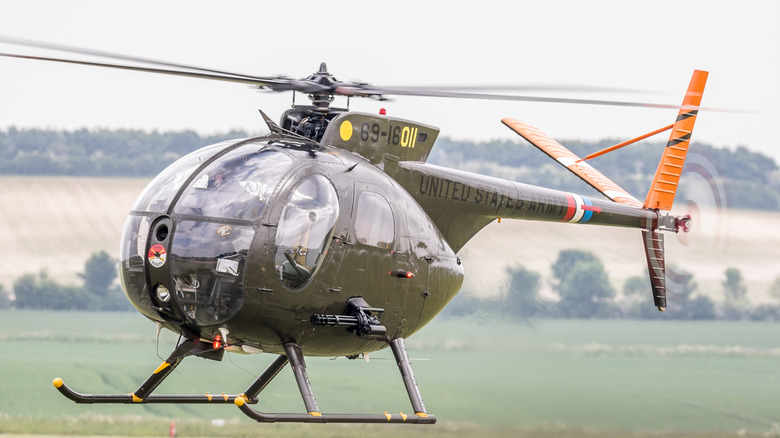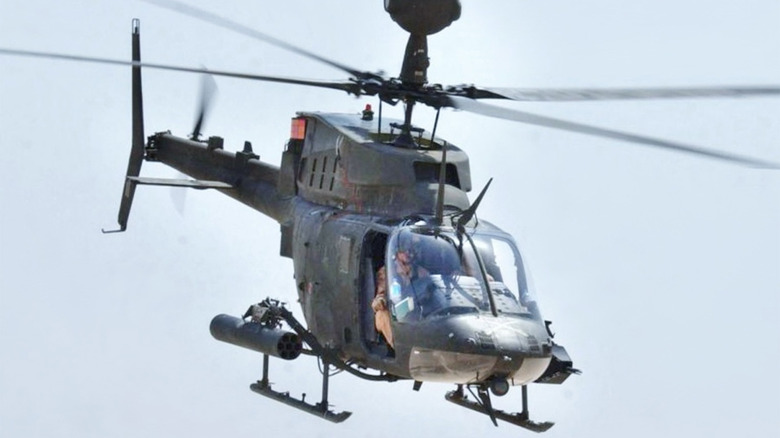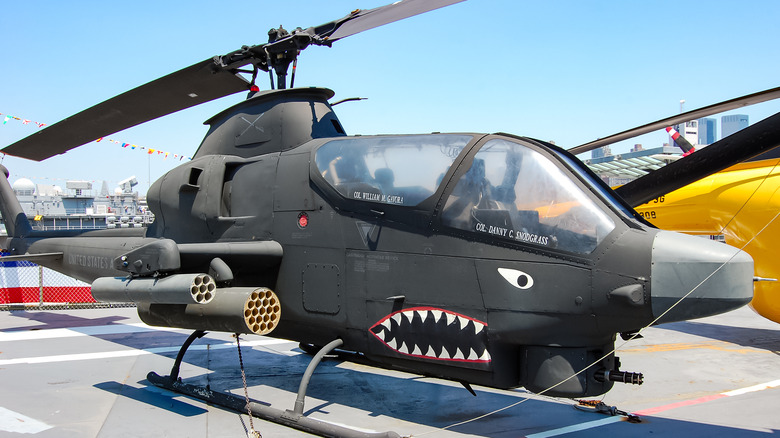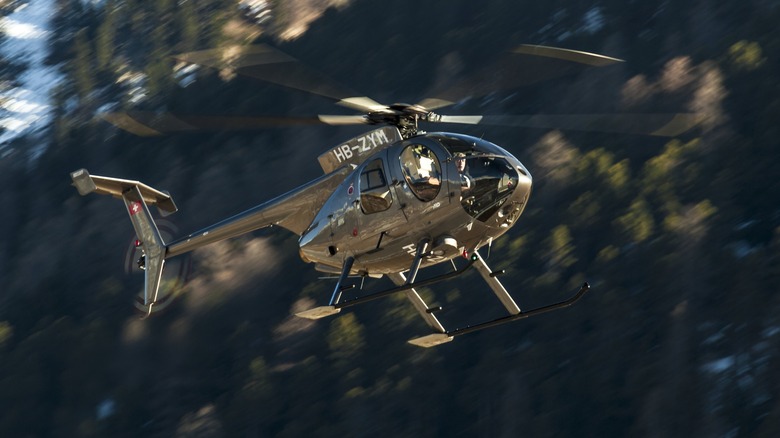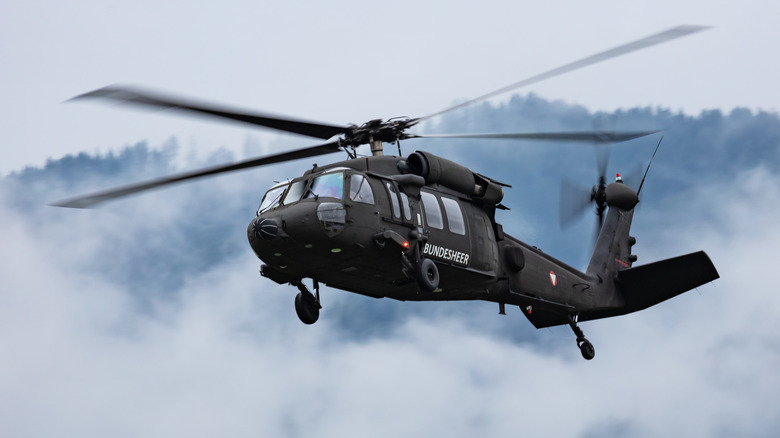9 Of The Oldest Military Helicopters Still In Service Today
Helicopters have an interesting history. The first helicopters were used by the military in World War II, and production ramped up once their usefulness for medevac, transport, cargo, and air-to-ground assault became evident. The Vietnam War saw a noticeable uptick in helicopter usage, as nearly 12,000 helicopters served in the war — a trend that never went down. Militaries around the world still use helicopters today in a variety of scenarios. The technology has improved, which allows helicopters to fly higher, faster, and safer than their older counterparts.
That said, a lot of those older helicopters are still in service today, some of which have become pretty iconic. You may be familiar with "Black Hawk Down," the popular war drama that references the Black Hawk helicopter. Beyond that, Chinook helicopters don't have the mainstream notoriety of something like the B-52 bomber – but almost everyone has heard of one.
Below we are taking a look at some of the military helicopters that are still flying today. There are varying reasons why these things are still around. They all have a good history when it comes to reliability, and replacing helicopters is extremely expensive, as with most military aircraft. There were also tens of thousands of these things produced so it makes sense that some are still getting used. Some of these still see use after over half a century — here are the oldest military helicopters still flying today.
Sikorsky H-34
The Sikorsky H-34 was introduced to the world in 1954 as an anti-submarine helicopter that was also used to haul cargo and troops. It started life as a helicopter for the U.S. Navy but eventually made its way to 25 other countries for use in both military and civilian services. Production of the H-34 ceased in 1970 with between 1,800 to 2,100 units manufactured in total, including subvariants, including those that flew under the CH-34 moniker. It retired from U.S. military service quite a while ago, but you can still find some floating around, pun intended, in the civilian sector.
The H-34 saw plenty of action during its heyday. It was mostly used by the U.S. in the Vietnam War. Afterward, it found a home in places like France, South Vietnam, Israel, and other countries. Famously, it was used to try and fetch NASA's Liberty Bell 7 out of the Atlantic Ocean but failed because the Mercury space capsule was filled with seawater.
There were well over a dozen variants of the H-34. Sikorsky modified it often in the 1960s for various other tasks. Thus, it's hard to find an example of the original version in the wild. Most on display in museums or used in civilian service are likely one of the variants, although the Palm Springs Air Museum regularly operates an original Sikorsky H-34.
Sikorsky SH-3 Sea King and S-61
The Sikorsky SH-3 Sea King and its civilian variant, the S-61, were introduced to the world in 1961. The SH-3 Sea King was an anti-submarine helicopter that was notably among the first helicopters to use turboshaft engines in its design. The military version of the helicopter was also among the first designed to both hunt and attack submarines. The job was previously done by two separate helicopters, one which did the hunting and another that di the attacking. Like most helicopters, it was retrofitted numerous times to take on other tasks. It was retired for military use in the U.S. Navy but still sees use by civilian companies to this day.
The civilian variant, the S-61, is also still used today. Some of the most well-known examples are the S-61s owned by Air Greenland, which have been owned and operated by the airliner for over 50 years. Despite being made specifically for civilian use, the Irish Coast Guard used them for search and rescue operations during the 1990s and 2000s. Most of the remaining helicopters still in use are the S-61 variant of the helicopter.
The S-61 is likely to stay in flight for quite some time. Sikorsky designed a modernized version, dubbed the S-61T, back in 2013. 110 of them were purchased by the U.S. State Department but rarely used. The State Department started auctioning them off to civilians in 2019. Thus, the S-61 legacy will continue for at least a little while longer.
Bell UH-1 Iroquois
The Bell UH-1 Iroquois is one of the most famous helicopters in the world. It entered service in 1962 as a medevac helicopter and played a massive role in the Vietnam War, where the helicopter was instrumental in evacuating over 900,000 wounded soldiers. It also transported cargo and troops. The final UH-1 officially retired from U.S. military service in 2016. However, there are reports of the U.S. Air Force still using newer versions of the chopper to this day.
What makes the Huey so unique are the various names it went under. Its official designation was the UH-1 Iroquois but got the name Huey from its original call sign, HU-1. It was also a Bell 204 series helicopter. Future variants were part of other product families, such as the TH-1H Huey II derived from the Bell 212 series. The helicopter eventually became a symbol of the U.S. military's involvement in Vietnam and is featured in a lot of media from that time period. Even the sound it makes is among the most recognizable of any helicopter. The Vietnam War era saw many iconic helicopters, but few were as well-known as the Huey.
Thanks to its popularity, the Huey likely isn't going anywhere anytime soon. There are just so many of them in so many places that it might be another couple of decades before they die out completely. You can even find repair manuals online if you ever wind up with one.
Boeing CH-47 Chinook
The Chinook was introduced in 1962, and the U.S. military uses it to this day, making it one of the oldest military aircraft that is still in use by the armed forces. It's a transport chopper used almost exclusively for hauling people and cargo from point A to point B. It uses a double-rotor design. Thanks to that, it can operate a lower RPM than a normal helicopter, leading to a distinctive sound that is recognizable from other helicopters.
The Chinook is an excellent overall helicopter, which is likely why it's still going after all this time. It's huge, quick, and reasonably durable. Modern versions of the Chinook can go roughly 186 mph for about 200 nautical miles and are capable of hauling over four dozen people or lugging around north of 20,000 lbs.
It's also been used in search and rescue operations as well as delivering goods to communities in the wake of natural disasters. One of the most famous Chinooks ever flown, Bravo November, hauled 2,150 troops, 95 casualties, 550 prisoners, and 550 tons of cargo for the British Royal Air Force during its 18-day Falklands War deployment.
Boeing still actively builds Chinooks. The company states that it's built and shipped over 1,200 units since the helicopter was introduced decades ago. There are so many examples of this helicopter still being used that it's essentially common knowledge that the Chinook isn't going anywhere anytime soon.
[Featured image by Cpl Tim Laurence RAF via Wikimedia Commons | Cropped and scaled | OGL v1.0]
Hughes OH-6 Cayuse
The Hughes OH-6 Cayuse entered operation in 1966. It was created in response to a request from the U.S. Army for a smaller, lighter helicopter for observation during the Vietnam War. The Army's designation of it as a Light Observation Helicopter, or LOH, caused soldiers to refer to it as the Loach. It was used for a variety of purposes during the war, and the CIA reportedly used it for covert operations as well. When the design first arrived, it set 23 helicopter world records. You've almost certainly seen this helicopter in movies and TV shows with its recognizable design.
The actual OH-6 was used for decades in the U.S. military along with several other countries, including Brazil, Japan, and Spain. Its design was spun off in later iterations to create a number of different variants. Japan began phasing them out for the Kawasaki built OH-1 in 2013, but the process is still ongoing so there are still some in service today. The choppers also still see heavy civilian use. They are popular among civilian pilots and law enforcement agencies.
There might be more of these helicopters in the sky if Hughes hadn't messed things up. The company owner, Howard Hughes, purposely underestimated the cost estimates to the U.S. Army. The Army caught wind of it and started a new contract competition to replace them.
Bell 206 series
The Bell 206 series of helicopters rolled out for the first time in 1967. These choppers have an interesting history. Bell lost an earlier military contract competition to Hughes, resulting in the OH-6. Hughes later bumbled the contract, resulting in a new contract competition that Bell won with the 206 series of helicopters. There are multiple variants in the lineup, including the 206, 206A JetRanger, 206L LongRanger, and the Bell OH-58. Additional variants included the AB 206 series and the SeaRanger for the U.S. Navy.
Bell produced over 7,000 of these helicopters by the time the last one exited production in 2017. Despite the huge number of models, the design is more or less the same. The only major differences between each model are the seating capacity and fuel range. The U.S. used the OH-58 variant as a reconnaissance helicopter up through the Gulf War. Australia, Canada, Chile, Jamaica, Malta, and Sweden are other countries that have used it for military operations.
Today, the helicopter is still used for military service in many countries in some form or another. Many folks living in large, urban areas may have seen a JetRanger flying overhead from time to time. News media organizations often use Bell 206 choppers for traffic updates and news reporting. Harrison Ford owns a Bell 407GX series chopper, which is a direct descendent of the 206L LongRanger. These things, and their descendants, are everywhere.
Bell AH-1 Cobra
The Bell AH-1 series of helicopters officially came out in 1967, just months after the Bell 206 series started shipping, and initially served as an attack helicopter in the Vietnam War. The design featured a chin-mounted turret and additional weaponry mounted on the sides. The AH-1 shares some components with the aforementioned Huey helicopter as well. In fact, the AH-1 is technically a descendant of the Huey but with a higher emphasis on offense.
The helicopter was part of the U.S. arsenal until the late 1990s and was used extensively in most conflicts between its inception and its decommission. Once the U.S. was done with it, it offered the AH-1 to its NATO allies, where it remains in service in my countries today.
Bell came out with a variety of models over the years to continually modernize the helicopter. For example, the AH-1J, or SuperCobra, came out in 1968 and remained in service for the U.S. military until 2020. When it was eventually let go, they were spread among the civilian sector. One of the modern uses for the AH-1 is by the U.S. Forest Service. The Forest Service's version of the helicopter comes equipped with low-light sensors and infrared cameras to monitor forest fires.
Bell's AH-1 was a popular helicopter for years, although it is massively overshadowed by the Hueys that this helicopter was designed from. Still, it had its place in military service for decades and still sees use today.
MD 500 series
The MD 500 series of helicopters were introduced into service in 1967, right alongside many others from the Vietnam War era. Like most, it had several variants, including the MD 500 Defender, MD 500E, MD 520N, and MD530F. All variants of the MD 500 have seen military use, but none more so than the MD 500 Defender, which is still actively used today.
It's a light utility helicopter that was mostly used for reconnaissance and utility work. Armed variants also exist for attack and anti-submarine uses as well. The chopper's breadth of uses and variants has helped it remain relevant throughout the years — there's an MD 500 for almost any occasion.
The U.S. military is the biggest individual user of the MD 500 series helicopter, but they're also used in Russia, China, India, South Korea, Japan, and several other countries. There aren't nearly as many of them in active military service as there used to be, but it seems like several countries are holding on to a few. Civilian versions of the helicopter are also still produced, although in much smaller numbers than in the past.
You've almost certainly seen these beauties before in the civilian world. They are the proverbial copper chopper as they are quite popular with law enforcement. They're also used for utilitarian tasks like spraying crop fields with pesticides and by movie studios for aerial filming. It's also among the more popular recreational helicopters. They should stick around for quite some time, thanks to their versatility.
Sikorsky UH-60 Black Hawk
The Sikorsky UH-60 Black Hawk is one of the most recognizable military helicopters of all time. It debuted in 1979, making it a fair bit newer than many of the other choppers on this list. However, unlike most of those choppers on this list, this one definitely has a long future of military service ahead of it. In fact, it'll remain in the U.S. Army until at least 2030 when the Future Long Range Assault Aircraft (FLRAA) program finds a suitable replacement. The Black Hawk is a multipurpose helicopter that was originally intended to replace the aging Bell UH-1 Huey to transport troops and light cargo from one place to another.
The Black Hawk has been updated over the years to perform a variety of tasks. One such example is the UH-60V, which featured various upgrades over the previous models. Those upgrades have helped the Black Hawk remain relevant for all these decades. It's even been outfitted with weapons for use during attacks. There isn't much that the Black Hawk isn't capable of doing, so the FLRAA has its work cut out for it.
Once its military service is over, the Black Hawk still has a home in the civilian sector. It's currently used as an air ambulance or an air crane, and some are even outfitted with large water tanks for use in fighting forest fires. Its natural speed makes it excellent for such roles, so it'll likely be a long time before Black Hawks retire for good.
